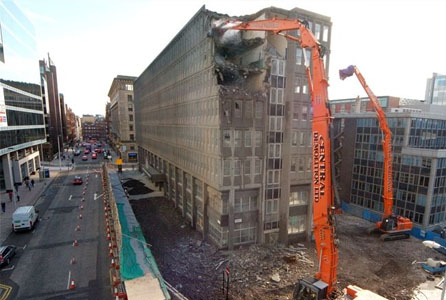
Demolition Safety
OSHA – Occupational Safety and Health Administration – says that many of the hazards that are associated with a construction project are pertinent to a demolition project. However, the risk is much larger when on a demolition site than on any construction sites. For example, workers are exposed to lead based paint as well as hazardous asbestos material in addition to any materials that could potentially be hidden with the structural walls! In order to combat the variety of unknown and unsteady parallels, it is necessary to take a few safety precautions: you’ll find the best way to go about this is by having a demolition safety checklist.
Perform an Engineering Survey
Prior to the commencement of any demolition project, OSHA requires that the on-site project manager perform an engineering survey of the demolition area. This survey will consist of examining the walls, floors and framing to determine their condition. The reason for this survey is to hopefully avoid any unnecessary, unexpected collapse of a room or the entire building. As a requirement by OSHA, there should always be a written evaluation on hand by the on-site project manager of this survey being conducted and the results acquired from the survey.
Personal Protective and Life Saving Equipment
It is required by OSHA that workers wear protective equipment, which has been approved by OSHA, that will protect their person and could potentially save their life in the right positions. Personal protective equipment could include protection for the head, face, eyes and other extremities. More specifically, the equipment includes respiratory devices that will protect from breathing in hazardous elements, protective clothing to avoid touching hazardous materials as well as eye glasses/goggles and hard hats/helmets to protect the head and eyes from any hazardous material contact. Other equipment could include lifelines, safety belts and ear protective gear. All of this equipment is to be provided by the employer or project manager and it should be inspected to be in proper working condition for adequate protection from any type of hazardous materials, chemical or radiological hazards, etc. that could cause potential harm to the health of the worker from inhalation, absorption or even physical contact.
Fall Prevention
Demolition projects often call for employees to work off the ground, floor or base foundation. In addition, there are open stairways within the building that could be an area for a fall just waiting to happen. With that being said, here are a few tip to prevent falls:
- Make certain that all damaged walls and floors have been braced prior to the worker entering the area while also ensuring that all holes have been properly covered with durable material that can withstand the worker and any other possible weight.
- Select, inspect, wear and use the appropriate personal protective equipment, also known as PPE, for the task being performed.
- Make certain that all demolition begins at the top and works downward for outside walls and floors.
- Do not work in an area where there are current structural hazards for collapse.
